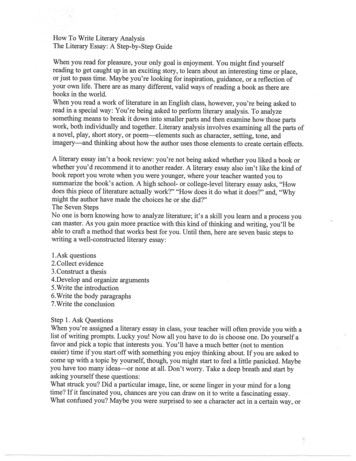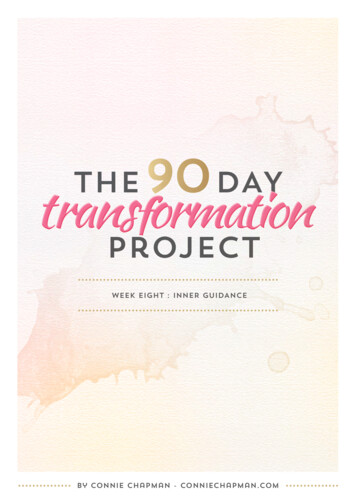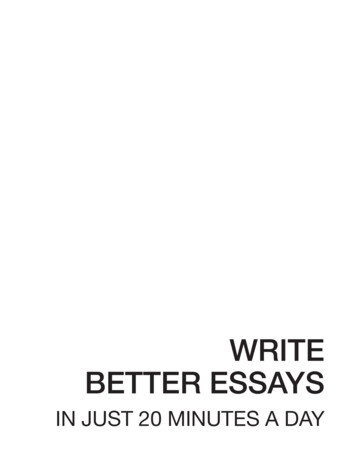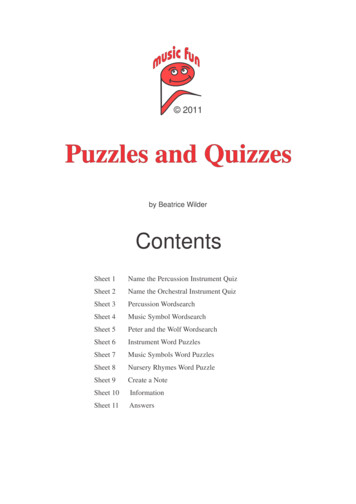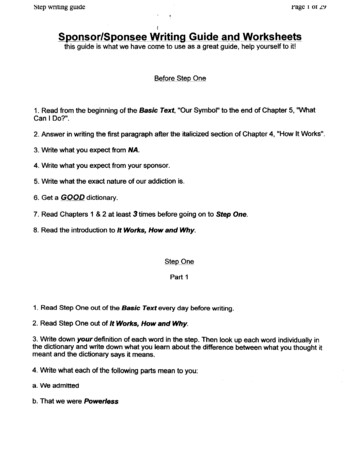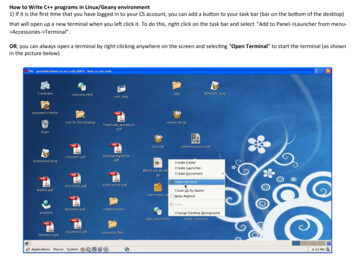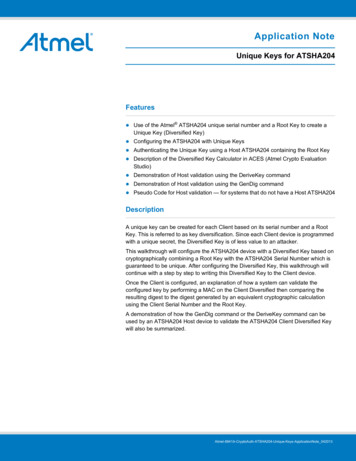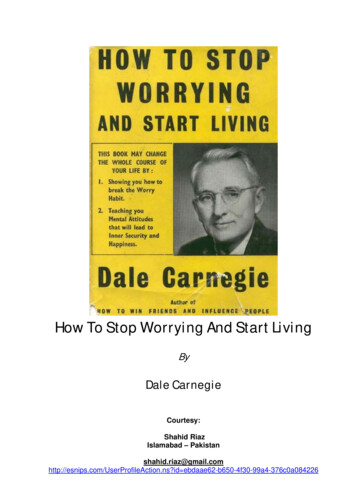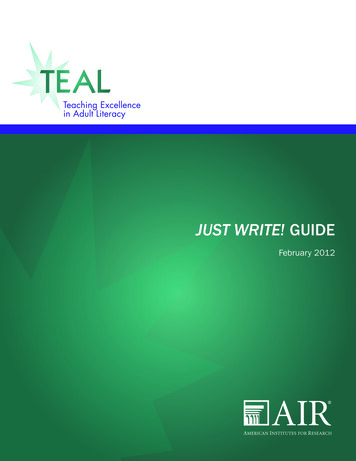
Transcription
JUST WRITE! GUIDEFebruary 2012
AcknowledgmentsWe appreciate the vision and guidance provided by the subject matter experts and U.S.Department of Education, Office of Vocational and Adult Education (OVAE) staff to the workof the Teaching Excellence in Adult Literacy (TEAL) Center.Mary Beth CurtisDolores PerinDirector, Special Education Centersand InstitutesProfessor of Psychology and EducationLesley UniversityColumbia UniversityNoel GreggDavid ScanlonAssociate Dean of Research, Collegeof EducationAssociate Professor, Departmentof Teacher Education, Special Education,and Curriculum & InstructionUniversity of GeorgiaTracey E. HallSenior Research Scientist/Instructional DesignerCAST, Inc.Charles “Skip” MacArthurProfessor, School of EducationUniversity of DelawareLinda MasonAssociate Professor, Educational andSchool Psychology and Special EducationTeachers CollegeBoston CollegeChristopher CoroDeputy Director, Division of Adult Educationand LiteracyU.S. Department of EducationOffice of Vocational and Adult EducationMary Jo MaralitEducation Program SpecialistU.S. Department of EducationOffice of Vocational and Adult EducationPennsylvania State UniversityTanya ShuyBrett MillerEducation Program SpecialistHealth Scientist AdministratorU.S. Department of EducationNational Institutes of Child Health andHuman DevelopmentOffice of Vocational and Adult EducationElizabeth “Boo” MurraySenior Research Scientist/InstructionalDesignerCAST, Inc.Just Write! Guide
Just Write! GuideFebruary 2012This report is in the public domain. Authorization to reproduce it in whole or in part is granted. Whilepermission to reprint this publication is not necessary, the citation should be:U.S. Department of Education, Office of Vocational and Adult Education. (2011). Just Write!Guide. Washington, DC: Author.This report is available on the Department’s website at https://teal.ed.gov/resources.
ContentsIntroductionIntroductory Letter . . . . . . . . . . . . . . . . . . . . . . . . . . . . . . . . . . . . . . . . . . . . . . . . . 2Why Write? Why Teach Writing? . . . . . . . . . . . . . . . . . . . . . . . . . . . . . . . . . . . . . . . . 4Overview . . . . . . . . . . . . . . . . . . . . . . . . . . . . . . . . . . . . . . . . . . . . . . . . . . . . . . . . 6Fact Sheet: Research-Based Writing Instruction . . . . . . . . . . . . . . . . . . . . . . . . . . 8Research-Based Writing InterventionsIncrease the Amount of Student Writing . . . . . . . . . . . . . . . . . . . . . . . . . . . . . . . . . 12Fact Sheet: Adult Learning Theories . . . . . . . . . . . . . . . . . . . . . . . . . . . . . . . . . 19Fact Sheet: Student-Centered Learning . . . . . . . . . . . . . . . . . . . . . . . . . . . . . . . 23Set and Monitor Goals . . . . . . . . . . . . . . . . . . . . . . . . . . . . . . . . . . . . . . . . . . . . . 26Fact Sheet: Self-Regulated Learning . . . . . . . . . . . . . . . . . . . . . . . . . . . . . . . . . 29Fact Sheet: Metacognitive Processes . . . . . . . . . . . . . . . . . . . . . . . . . . . . . . . . . 32Combine Sentences . . . . . . . . . . . . . . . . . . . . . . . . . . . . . . . . . . . . . . . . . . . . . . . 36Teach Self-Regulated Strategy Development . . . . . . . . . . . . . . . . . . . . . . . . . . . . . . 39Fact Sheet: Self-Regulated Strategy Development . . . . . . . . . . . . . . . . . . . . . . . . 40Teach Summarization . . . . . . . . . . . . . . . . . . . . . . . . . . . . . . . . . . . . . . . . . . . . . . 44Make Use of Frames . . . . . . . . . . . . . . . . . . . . . . . . . . . . . . . . . . . . . . . . . . . . . . 46Provide Constructive Feedback . . . . . . . . . . . . . . . . . . . . . . . . . . . . . . . . . . . . . . . 48Enhancing Teaching PracticesApply Universal Design for Learning . . . . . . . . . . . . . . . . . . . . . . . . . . . . . . . . . . . 52Fact Sheet: Universal Design for Learning. . . . . . . . . . . . . . . . . . . . . . . . . . . . . . 55Check for Understanding . . . . . . . . . . . . . . . . . . . . . . . . . . . . . . . . . . . . . . . . . . . 58Fact Sheet: Formative Assessment . . . . . . . . . . . . . . . . . . . . . . . . . . . . . . . . . . 60Differentiate Instruction . . . . . . . . . . . . . . . . . . . . . . . . . . . . . . . . . . . . . . . . . . . . 63Fact Sheet: Differentiated Instruction . . . . . . . . . . . . . . . . . . . . . . . . . . . . . . . . . 68Gradual Release of Responsibility . . . . . . . . . . . . . . . . . . . . . . . . . . . . . . . . . . . . . 71Join a Professional Learning Community . . . . . . . . . . . . . . . . . . . . . . . . . . . . . . . . 74Look at Student Work Regularly . . . . . . . . . . . . . . . . . . . . . . . . . . . . . . . . . . . . . . 76Fact Sheet: Effective Lesson Planning . . . . . . . . . . . . . . . . . . . . . . . . . . . . . . . . 79Use Technology Effectively . . . . . . . . . . . . . . . . . . . . . . . . . . . . . . . . . . . . . . . . . . 82Fact Sheet: Technology-Supported Writing Instruction . . . . . . . . . . . . . . . . . . . . . 85Glossary . . . . . . . . . . . . . . . . . . . . . . . . . . . . . . . . . . . . . . . . . . . . . . . . . . . . . . . . . 89Just Write! Guide
Introduction
Mary Ann Corley, Ph.D., TEAL DirectorLarry Condell, Ph.D., Managing DirectorHTTPS://TEAL.ED.GOV/February 1, 2012It is my pleasure to introduce you to the Teaching Excellence in Adult Literacy (TEAL) Just Write! Guide.This guide is the culmination of two years of work in identifying research-based instructional practices inthe content area of writing. It also incorporates professional wisdom gleaned from participants in the sixTEAL online courses on effective instruction.A word about the background of TEAL: American Institutes for Research, through a contract awarded bythe U.S. Department of Education Office of Vocational and Adult Education (OVAE), assists OVAE in itsefforts to enhance state and local adult education providers’ capacity to understand and apply evidencebased instructional practices that promote student learning. The TEAL Center is designed to improve thequality of adult education teaching in content areas. Focused on the content area of writing for adult basiceducation (ABE) students, the TEAL Center offers an intensive program of professional development andindividualized technical assistance.Because content knowledge is but one important facet of quality instruction, TEAL Center staffdeveloped a series of six online courses to help teachers become familiar with the equally importantelements of quality teaching: research-based processes and approaches. Accordingly, teams of teachersand a professional development coordinator from 12 states participated in the first round of onlinecourses and the field test of TEAL materials; they engaged in online courses from October 2010through July 2011 on the following topics: Strategy Instruction Self-Regulated Learning Universal Design for Learning Formative Assessment Differentiated Instruction Effective Lesson PlanningThrough the online courses, participants across the 12 states formed an online community of practicein which they could share ideas and resources and discuss possible solutions to instructional challengesencountered in the ABE classroom. The capstone event was the TEAL Summer Institute in August 2011,during which participants engaged in hands-on activities facilitated by leading researchers in writinginstruction and had the opportunity to weave together all they learned through the online courses abouteffective instruction, consider this learning in the context of writing instruction, and develop and sharelesson plans for teaching writing strategies.PA G E 2Just Write! Guide
The Just Write! Guide is a resource guide for ABE teachers, intended to increase familiarity withevidence-based writing instruction and to facilitate translation of research findings into teaching practicesand products that will enhance the quality of instruction delivered to adult learners. We hope that the guidewill inspire adult education teachers to write more, think more deeply about the writing they do with theirstudents, and consider how to enhance their instruction overall.Numerous individuals helped with the development of this guide and the online courses. First andforemost, on behalf of AIR, I offer a hearty thank you to Heidi Silver-Pacuilla, the principal researcherwho led the conceptualization and development of the guide and the online courses. I also offer sincereappreciation to the TEAL subject matter experts who willingly reviewed and provided guidance to TEALstaff along our journey as we fashioned the guide and the courses: Mary Beth Curtis, Noel Gregg, TraceyHall, Charles “Skip” MacArthur, Linda Mason, Brett Miller, Elizabeth “Boo” Murray, Dolores Perin,David Scanlon, and Tanya Shuy. In addition, I extend appreciation to the OVAE staff members whoprovided constant support throughout the development of the online courses and guide: Chris Coro andMary Jo Marali, as well as to AIR staff members who have supported this effort at numerous junctures:Mark Kutner, Larry Condelli, Mariesa Cash, Melissa Storm, Dahlia Shaewitz, Barbera Crawford, HelenDuffy, W. Christine Rauscher, Renee Sherman, Marcela Movit, Adam Battle, Rachel Goins, Scott Buckley,and Kip Thomson.For additional information, visit the TEAL website at https://teal.ed.gov, or contact the TEAL Centerat teal@air.org.Sincerely,Mary Ann Corley, Ph.D.Director, TEAL Center, andPrincipal Research Analyst,American Institutes for ResearchJust Write! GuidePA G E 3
Why Write? Why Teach Writing?Adults communicate in writing on a daily basis through notes to children’s teachers, workactivity logs and forms, e-mails to family and co-workers, online service forms, shoppinglists, and so on. Adults in postsecondary education or technical training courses faceexpectations to produce a variety of writing products from lecture notes, summaries,and critiques to research papers and essays. The pervasiveness of writing in daily lifeunderscores the need for learners and their instructors to focus on adults becomingflexible, fluent, and confident writers.There is plenty of evidence to suggest that many adults in America are not flexible, fluent,confident writers. National reports decry that nearly 40 percent of community collegeregistrants have skills below the college level and are referred to developmental instructionin reading, writing, or mathematics (Strong American Schools, 2008). Similarly, reportsdocument that the writing demands of most jobs—even at the entry level—are increasing,and businesses are stressed to provide the remedial writing instruction that workers need(Business Roundtable, 2009; Casner-Lotto & Barrington, 2006; Graham & Perin, 2007).The urgency of this situation is further heightened by the introduction of the CommonCore State Standards (CCSS) framework’s College and Career Ready Benchmarks. CCSSis an initiative of the National Governors Association and the Council of Chief StateSchool Officers to write academic standards that are “(1) research and evidence based,(2) aligned with college and work expectations, (3) rigorous, and (4) internationallybenchmarked” (CCSS Initiative, 2010, p. 3). These standards have been adopted in46 states and will be the basis of student K–12 assessments, as well as the revisedGED tests, to be released in 2014, in cooperative development with two consortia ofstates and publishers.The CCSS Initiative represents the latest of many national efforts to increase standardsand expectations for K–12 education and to elucidate the lack of alignment betweensecondary and postsecondary expectations (ACT, 2008; CCSS Initiative, 2010; NationalCommission on Writing, 2006). For adult education, the adoption of CCSS representsa significant increase in the expectations for learners and writing instruction. The CCSSdescription of College and Career Ready writing includes the following:To be college- and career-ready writers, students must take task, purpose, andaudience into careful consideration, choosing words, information, structures, andformats deliberately. They need to know how to combine elements of different kindsof writing—for example, to use narrative strategies within argument and explanationwithin narrative—to produce complex and nuanced writing. They need to be able touse technology strategically when creating, refining, and collaborating on writing.They have to become adept at gathering information, evaluating sources, and citingmaterial accurately, reporting findings from their research and analysis of sources ina clear and cogent manner. They must have the flexibility, concentration, and fluencyto produce high-quality first draft text under a tight deadline as well as the capacityto revisit and make improvements to a piece of writing over multiple drafts whencircumstances encourage or require it. (CCSS Initiative, 2010, p. 41)PA G E 4Just Write! Guide
Preparing adult learners for further education or work advancement requires thateducators help learners improve their writing skills, increase confidence in their ability towrite, and embrace the goal of writing well as a means of communication and expression.ReferencesACT. (2008). ACT’s college readiness system: Meeting the challenge of a changing world.Iowa City, IA: Author.Business Roundtable. (2009). Getting ahead—staying ahead: Helping America’s workforcesucceed in the 21st century. Washington, DC: Author. Retrieved December 27, 2011,from ndtable.pdfCasner-Lotto, J., & Barrington, L. (2006). Are they really ready to work? Employers’perspectives on the basic knowledge and applied skills of new entrants to the 21stcentury workforce. New York: The Conference Board, Inc.; Partnership for 21st CenturySkills; Corporate Voices for Working Families; and Society for Human ResourceManagement. Retrieved December 27, 2011, from http://www.p21.org/documents/FINAL REPORT PDF09-29-06.pdfCommon Core State Standards Initiative. (2010). Common Core State Standards forEnglish language arts & literacy in history/social studies, science, and technicalsubjects. Washington, DC: Author. Retrieved December 27, 2011, from http://www.corestandards.org/assets/CCSSI ELA%20Standards.pdfGraham, S., & Perin, D. (2007). Writing next: Effective strategies to improve writing ofadolescents in middle and high school. Washington, DC: Alliance for ExcellentEducation.The National Commission on Writing. (2006). Writing and school reform. New York: CollegeBoard. Retrieved December 27, 2011, from ng American Schools. (2008). Diploma to nowhere. Washington, DC: Author. RetrievedDecember 27, 2011, from omaToNowhere.pdfJust Write! GuidePA G E 5
OverviewThe purpose of the TEAL project is to improve the quality of teaching in adult educationin the content areas. The TEAL Center offers participating state teams an intensiveprogram of professional development and individualized technical assistance in the areaof writing instruction for adult basic education students. In addition, TEAL focuses onevidence-based instructional approaches that are effective across the content areas(e.g., formative assessment, differentiated instruction, self-regulated learning, effectivelesson planning, and UDL). Evidence-based instruction means that there is reliable,trustworthy, and valid evidence to suggest that particular instructional practices areeffective and successful in helping students learn.The TEAL Just Write! Guide represents the culmination of two years of work identifyingresearch-based instructional practices in the content area of writing. It also incorporatesprofessional wisdom from participants in six online courses that TEAL provided to adulteducators during the second year of the project. The intent of the guide is to increase thefamiliarity of adult basic education teachers with evidence-based writing instruction andto facilitate translation of research findings into teaching practices and products that willenhance the quality of instruction delivered to adult learners.This guide aims to help adult education instructors improve the writing instruction theyalready use in their programs. As such, the guide is not a curriculum; rather, it is intended tostrengthen existing writing instruction. We hope that this guide will inspire and guide adulteducation teachers to write more, think more deeply about the writing they do with theirlearners, and consider how to enhance their instruction overall.To begin, we specify a set of assumptions about the writing process to position our workwithin the larger academic conversation about literacy development. The TEAL Center staffand our advisors consider writing to be the following: A language-based process that includes oral language, reading, and writing A complex social and cognitive process A process that carries a significant affective or emotional element that affectslearners’ motivation and engagementWe also believe that research can inform practice. We know that the literacy researchbase is stronger in K–12 and postsecondary settings and weaker in adult educationsettings; therefore, we have extrapolated and contextualized findings and recommendationsbased on our experiences serving adult education students and teachers. Researchcitations are provided throughout the guide to ground our recommendations; these andthe annotated bibliography of research in writing instruction for adults, available on theTEAL website (https://teal.ed.gov/biblio), form the evidence base on which we havedrawn these recommendations.This approach has been developed and field-tested with participants in our 12 state pilotprograms; their input into the materials has been invaluable. Their voices are representedin the guide as they shared reflections on their own learning or relayed stories of howadult learners responded to the activities. We are indebted to their dedication to theirstudents’ success and enthusiastic participation in the online courses in which thesematerials were first presented.PA G E 6Just Write! Guide
We also strongly believe that writing instruction, as with all other instruction, should bebased on diagnostic information, such as a thoughtfully analyzed writing sample that canbe used to personalize and differentiate instruction. We provide suggestions throughoutthe guide on how to gather and analyze information from students. Finally, we add ourvoices to the call for more research and research-based diagnostic rubrics and tools inthis area for the adult education population.Organization of the GuideThe guide is presented in three parts:1. Introduction – background information about the project and research-basedinformation2. Research-Based Interventions – writing practices and activities to support thewriting process3. Enhancing Teaching Practices – best practice approaches and how they can serveimproved writing instructionThe guide is designed for use by adult education administrators and professionaldevelopment specialists, coaches and mentors, and adult education teachers at allstages of professional development. It is a resource they can turn to again and againto review models and best practices. The guide has been written for those who areinterested in writing as a process and who would like to use their understanding ofthe concepts presented herein for designing classroom instruction or professionaldevelopment opportunities. (For additional information, see the TEAL Center Fact Sheeton Research-Based Writing Instruction at the end of this section.)Just Write! GuidePA G E 7
TEAL Center Fact Sheet No. 1: Research-Based Writing InstructionRevised 2012Research-Based Writing InstructionWhy Teach Writing to Adult Learners?Recent research reviews have gathered what weknow about effective practices for teaching writing toadolescents. This fact sheet examines the research onwriting instruction for youth and adults, with attentionto those who struggle to learn. Extrapolating from thesemajor analyses provides guidance for adult educatorsto boost their writing instruction for adult learners.Adults encounter writing tasks on a daily basis, especiallyinformational or expository writing such as notes to children’steachers, grocery lists, work activity logs and forms, emails tofamily and co-workers, online service forms, and so on. Thepervasiveness of writing in daily life underscores the needfor learners and their instructors to focus on helping adultsbecome flexible, confident writers.Recent reviews of research have gathered what we know abouteffective practices to teach writing. Writing Next (Graham & Perin,2007b), and a companion analysis, “What We Know and WhatWe Still Need to Know” (Graham & Perin, 2007a), examine theresearch on writing instruction in grades 4–12, with attentiongiven to those whose writing skills need improvement. Writingto Read (Graham & Hebert, 2010) analyzes the research onhow writing instruction and practice can improve reading skills.Although these studies focus on students younger than mostof the adult education population, they provide direction forinstruction with adults. This fact sheet provides a thumbnailsketch of these three major studies and the implications foradult educators and learners.There is plenty of evidence to suggest that many adults ofall ages in America are not flexible, confident writers. WritingNext and Writing to Read provide grim statistics showing thatpoor in-school performance and high drop-out rates from highschool lead to a situation in which adults are underpreparedfor postsecondary education or successful employment.For example, they report that nearly a quarter of communitycollege registrants show the need for developmentalwriting instruction. Similarly, the reports document that thewriting demands of most jobs—even at the entry level—areincreasing and businesses may have to provide the remedialwriting instruction that workers need. Preparing adult studentsfor fur ther education or work advancement requires thatadult educators help learners improve their writing skills andincrease their confidence in their ability to write.Elements of WritingWhat’s the Research?Writing is multifaceted and includes a number of skills thatmust work together. Evaluating writing can be subjective wheninstructors and learners alike are unsure of what makes“good” writing. Writing “quality” is defined in Writing Nextas “coherently organized essays containing well developedand pertinent ideas, supporting examples, and appropriatedetail” (Graham & Perin, 2007b, p. 14). Sentence structureand vocabulary are other key elements that contribute tothe quality of a piece of writing. Learners who find writingdifficult may experience challenges in any of these areas aswell as in spelling, handwriting, prior knowledge of the topic,and familiarity with models of academic literacies or genres.Because writing is such a complex act, high-quality writingdepends on this large constellation of skills and abilities. Thegoal of writing instruction is to help writers become flexible;proficient; and able to adapt to various purposes, contexts, andformats, and, in so doing, to synergize literacy development inboth writing and reading.Writing Next and Writing to Read are metaanalyses, that is, largescale statistical reviews of studies that compare treatmentand control groups. A metaanalysis allows researchers tocombine multiple studies of a single instructional interventionand report “effect sizes” as an effectiveness measure. Aneffect size tells whether statistically significant findings arealso educationally meaningful. Writing Next analyzed 142studies and Writing to Read analyzed 93 studies. What WeKnow extends the conclusions of Writing Next by reviewingarticles that did not fit the strict inclusion criteria, including 48single-subject studies of writing, many of which were focusedon students who had learning disabilities or were otherwiselow achieving. Because there is very little rigorous research onthe effectiveness of literacy interventions for adult learners,it is necessary to refer to studies with younger students. Thechallenge for the adult education community is to extrapolatefrom reports on younger students and apply these findings inAbout Writing Instruction
TEAL Center Fact Sheet No. 1: Research-Based Writing Instructioninstructional design for adults. We already know, for example,that many native English speaking adult learners were lowachieving students in K–12 and many have undiagnosedlearning disabilities (Corley & Taymans, 2002; NationalInstitute for Literacy, 2009). We also know from adult learningtheory that adults show different learning patterns andlevels of motivation from adolescents and younger children,and it is necessary to take these differences into accountwhen drawing from work with younger populations to plan forinstruction with adults. There are also some studies of writingdevelopment in adults and youth in postsecondary settingsthat fill in some of the gaps and help us develop approachesto helping adults improve their writing abilities.Recommended Instructional StrategiesAll three reports find that writing instruction should emphasizeexplicit, direct, and systematic instruction with manyopportunities for learners to engage in meaningful, extendedwriting. Learners who wish to improve their writing skills willbenefit from learning strategies, and from assistance given bypeers, mentors, and technology tools.Writing Next, What We Know, and Writing to Read found thefollowing instructional interventions to be effective. Thosethat are especially helpful for low-achieving writers are noted.This TEAL Center Fact Sheet offers in italics suggestions forcontextualizing instruction in the adult education setting. Strategy instruction, especially self-regulated strategydevelopment (SRSD), and summarization describedbelow, are the most effective approaches identified inthese reports. Writers who are explicitly taught strategiesthat are reinforced in class over time can internalizethese strategies and draw on them for support whenwriting. Strategies replace negative self-talk with positiveself-instructions to help students overcome frustrationand past failure. Strategy instruction has been introducedto adult education through the professional developmentprograms, Bridges to Practice and Learning to Achieve,developed by the National Institute for Literacy to addressthe needs of students with learning disabilities. It isan instructional approach that requires professionaldevelopment and practice leading to instruction that isconsistent and explicit. Summarization. Explicit teaching of the elements of asummar y of a text leads to improved ability andRevised 2012increased confidence in writing summaries. Havinglearners write summaries about what they read is a keyrecommendation from Writing to Read. In addition,summarization is an increasingly common expectationas students advance in their education and are assignedmore complex texts to read and comprehend. Connectthis instruction and practice with increasingly complextexts to reinforce learners’ comprehension as well aswriting skills. Collaborative writing. Making arrangements for studentsto work together through the entire process of writing—planning, drafting, revising, editing, and publishing—results in higher quality writing products. Use technologyto support and share writing, especially for classes that donot meet daily, or assign writing as an out-of-class activity. Setting specific product goals. Understanding thenature of goals for a written product, setting the goal inadvance during planning, and then monitoring and editingone’s work for adherence to the goal all result in higherquality final products. Specific goals (e.g., “to persuadea voter”) are more effective than general goals (e.g.,“write a 200-word essay”). Discuss writing quality withlearners and identify areas for improvement. Help learnersset explicit goals to guide their writing, and work with themto track progress. For example, learners may want to writemore words during a Quick or Free Write exercise; othersmay identify that their sentences are all of a similar typeand want to focus on adding variety and using combinedsentences. Tracking goals works! Word processing and other technology tools areespecially supportive for struggling writers, providing themeans to move more easily from idea to composition,suppor ting spelling, revising, and proof reading.Technology-assisted writing also makes collaborativewriting (see above) more feasible and productive. Sentence combining, that is, practicing how to combinetwo simple sentences into a compound or complexsentence, has a positive impact on overall writing qualityand can boost learners’ reading comprehension skillsas well. Use this technique in conjunction with othereffective writing techniques, such as encouraging peerdiscussion as part of collaborative writing, to helpreinforce the practice.Just Write! GuidePA G E 9
TEAL Center Fact Sheet No. 1: Research-Based Writing Instruction Prewriting activities, or brainstorming before beginningto draft a composition, has a positive impact on the finalwritten product. Prewriting activities can be doneindividually or as a collaborative process. This planningstrategy may be particularly important to low-achievingwriters for compensating and overcoming documentedweak prior knowledge and vocabulary (Graham & Perin,2007). Engaging learners and supporting vocabularydevelopment and background knowledge through prereading strategies can support writing about the topic,too. Generate lists, word webs, and personal glossariesthat can help writers demonstrate what they know. Inquiry, in which learners engage in a focused investigationwith “immediate and concrete data” (Graham &
Just Write! Guide PAGE 3 The Just Write! Guide is a resource guide for ABE teachers, intended to increase familiarity with evidence-based writing instruction and to facilitate
